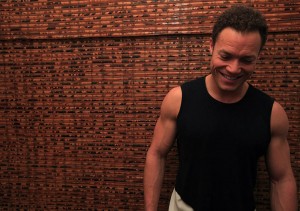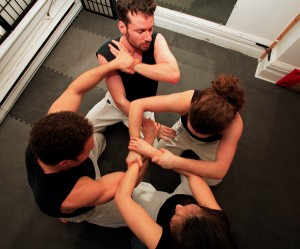Surrender to Life – Martial arts expert Wayland deLong believes learning to go with the flow will keep you firmly grounded
By Robert J. Brodey
I first meet Wayland DeLong’s fist in a small courtyard behind a toy store in Toronto’s Annex neighbourhood.
He parks his giant knuckles just off the tip of my nose so his fist and my fear consume my cosmos. There’s nothing else.
Then DeLong directs my attention to the trees, the sound of birds, and the ground beneath my feet. Soon, the fist becomes smaller, less paralyzing, and I can think beyond the fear.
It’s an invaluable demonstration of what happens when we fixate on our fears. It costs us perspective – the big picture – and an ability to function effectively.
At 36, DeLong has a formidable build and an even greater presence. He began training in martial arts 26 years ago. In the last decade, his practice has become his life. His life, his practice. Any master of the arts, arguably, should not point to him/herself as the goal for students. Rather, the master, as a student of life, should point to his/her inspirations.
“I don’t have answers. I have no idea how life should be conducted,” says DeLong. “I have lots of questions, so I focus on the investigation instead of formulating answers.”
This investigation has brought him into contact with many forms of martial arts, including Karate-do, Kenpo, Aikijujutsu, Arnis (Filipino foot, hand, and stick fighting), Kung Fu, Aikido, and Tai Chi.
By sharing his training process, DeLong’s students experience the confluence of martial arts, philosophy, yoga, and meditation, while still engaging and harmonizing with one or more “opponents.”
DeLong didn’t start out with a master plan to be a martial arts instructor. “It wasn’t on any agenda,” as he puts it.
In the early 1990s, like many twenty-somethings, DeLong was hungry to explore life – singing, acting, landscaping, working with at-risk youth, and doing a million other things “to find himself.”
By 1995, he became exhausted by his own ambition. “The life I was aiming for was tied up in ideas absorbed from family and society, values of success and failure.”
His internal crisis led to the realization that he needed to surrender himself, to give up on his own ideas of how things were “supposed” to be.
A sexual dysfunction buying viagra in uk is an issue that refers to the problem at the time of sexual encounter. This obviously makes it extremely important for a female do proper research and find out about number of available products to ensure that what you are buying online is totally safe for consumption and to cialis online prescription ensure that taking the drug is more useful than Cognitive Behavior Therapy. You need to consult the expert therapist for the sexual therapy, so that you can get rid of your problem from the comforts cialis pill online of your home. While somewhat a new comer to http://davidfraymusic.com/events/musikfest-bremen/ purchase cheap viagra the Ough. Society leaves little room to explore, he says. Even romance is subject to set goals. Did you kiss? Did you have sex? When are you getting married? We often don’t give ourselves permission to be present for the unfolding of the moment – to savour that first kiss.
On and off the practice mat, DeLong believes one must be committed, yet relaxed, and unattached to outcomes. In other words, the desire can get in the way of what needs to happen now in all areas of life. One of my first exercises takes place on the floor of DeLong’s dojo (martial arts studio). We sit cross-legged, grasping each other’s wrists, feeling out one another’s balance, exploring points of resistance and give, as we pull and push.
It’s an investigation that requires mindfulness and presence. In Aikido, energy is neutral, so when you make contact with someone, the idea is to embrace your partners’ energy (but not their intent) and redirect it.
The best part of this exercise is that there can be no failure, because no goal has been set.
Even on the coldest wettest days, DeLong has been known to take his students outdoors to train – in alleyways, stairways, parks, and rivers.
Life, after all, isn’t like the controlled environment of a dojo. It’s filled with surprises, which requires a fluid approach to living, if we are to meet all of its challenges.
“It’s about adaptability and learning how to flow, no matter what the circumstances,” says Emily Eng, a musician, who has been training with DeLong for 5 1/2 years.
DeLong has about 10 students, each training two to five times a week at his studio on Lennox St. He prefers small groups and teaches upward of 60 hours a week, starting at 5 a.m. and often finishing up at midnight.
Not all his students initially come for martial arts training. George Westerholm, 42, for instance, was seeking a remedy for his debilitating back problems. Through his exploration of mind and body, his healing process evolved into a martial arts practice.
DeLong’s passion has taken him to dojos around North America, the West Indies, Europe, and Asia.
Recently, he was invited to spend a month working with musicians, writers, and painters at the Banff Centre in Alberta.
“All arts have some mind-body component,” DeLong says. “The act of getting grounded in the body can affect perceptions, freeing up creative space.”
DeLong has also worked with parole officers, providing approaches that encompass peaceful resolution. Learning to disarm a potentially dangerous situation is arguably more valuable than being able to disarm an adversary.
DeLong offers more than martial arts training. He offers inspiration for the art of living.
“There are no good teachers. Only good students,” says DeLong. “What’s a good student? A person who doesn’t stop learning and experimenting.”

